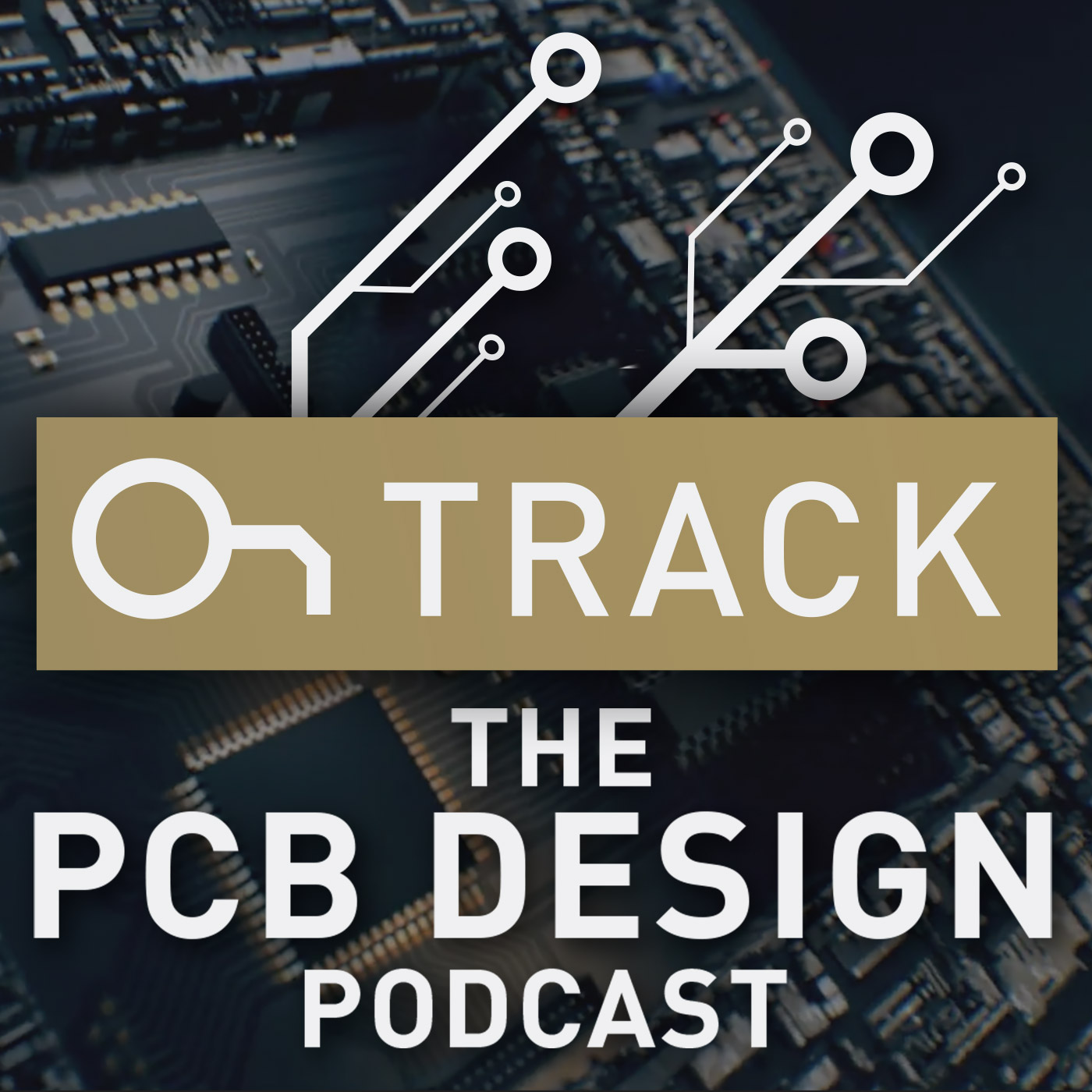Episodes
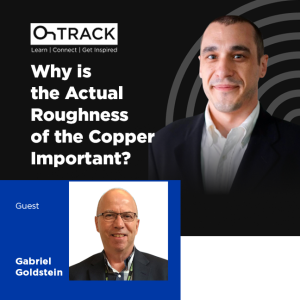
Sunday Jul 31, 2022
Roughness of the Copper and its Effect on the Signal Integrity
Sunday Jul 31, 2022
Sunday Jul 31, 2022
I am very honored to have Bert Simonovich, a very well-known expert in the signal integrity community, in today’s episode. Bert developed the "Cannonball-Huray" model used for transmission line loss modeling, which has been adopted in several popular EDA tools.
We will be discussing several topics relating to copper roughness, including different approaches to ensure signal integrity in your PCB design.
Altium 365: Where the World Designs Electronics
Show Highlights:
- Bert shares his background and experience
- He did his microprocessor systems back in the late '70s and later worked at Bell-Northern Research in Ottawa, Canada
- In the 90s he transitioned to Nortel from where he specialized in backplane design and signal integrity
- He founded Lamsim in 2009
- Bert retrospects using photo tools which is now the photo plotting with Gerbers. His experience helped him understand the mechanics of PCB construction
- A client’s demand led to extensive research involving dielectric material comparisons and foil roughness
- With various PCB surface roughness models, how to determine which process to move forward with?
- Bert explains the Design Feedback Method
- Cannonball technique is a roughness modeling approach which Bert also described as a heuristic method
- Checkout Bert’s articles on SI Journal
- Bert gives a detailed explanation of how copper is being used in PCBs
- HDP user group international published a research paper Smooth Copper Signal Integrity in 2016
- Bert and Zach agree that PCB construction is complicated and it is highly recommended for PCB designers and SI engineers to learn more about the fabrication process
- What does reverse treated foil means, and how does it relate to the power layer?
- Read Bert’s DesignCon Paper: A Practical Method to Model Effective Permittivity and Phase Delay Due to Conductor Surface Roughness
Links and Resources:
Connect with Bert Simonovich on LinkedIn
Follow Lamsim Enterprises Inc. on LinkedIn
Visit Lamsim Enterprises Inc. website
Read Bert’s Articles on SI Journal
Get Your First Month of Altium Designer® for FREE
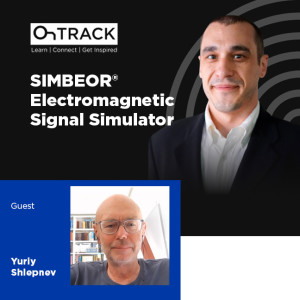
Sunday Jul 24, 2022
Sunday Jul 24, 2022
Making electromagnetic analysis accessible to anyone in the industry is what inspired Yuriy to create SIMBEOR® Electromagnetic Signal Simulator.
Yuriy Shlepnev is the founder and president of Simberian. In this episode, he will tell us about Simbeor simulation capabilities, and briefly educate us on rise times, signal integrity, and solving EMI. He will also show us the simulator in action and how it can be a lifesaver to PCB designers like you.
Tune in, enjoy and don't forget to check the additional resources below.
Altium 365: Where the World Designs Electronics
Show Highlights:
- uriy talks about his background in computational electromagnetics and how he got started working on simulations for PCBs and magnetic analysis
- Simulation capabilities accessible to lower data rates, Yuriy discusses rise times, signal integrity, and solving EMI simultaneously
- SIMBEOR® 2022 includes three simulation modes, and one of them is the Fast SI which uses more approximate models for pins, pads, and vias. It is a full wave, but not 3D. It allows simulations to run faster for more mass, included
- Simbeor SDK, a built-in software development kit in Altium Designer’s stackup manager. It uses the SFS solver for cross-sectional analysis, and that benefits Altium customers
- Yuriy shows us the 3D field solver in action
- Simulation of fiber weave effect on PCBs, is it possible?
- Coming soon in Simbeor SDK is the ability to build your own simulation tools
- Monte Carlo analysis is a perfect way to convert numeric model variations into a probability distribution
- What is the future of SIMBEOR® that designers can use to help them expedite important analyses for high-speed and RF designs?
Links and Resources:
Connect with Yuriy Shlepnev on LinkedIn
Visit Simberian website and learn more about SIMBEOR® Electromagnetic Signal Integrity Software
Read Yuriy’s Articles in SI Journal
Watch a related podcast episode: Simberian’s 3D Field Solver in Altium Designer
Full OnTrack Podcast Library
Altium Website
Get Your First Month of Altium Designer® for FREE
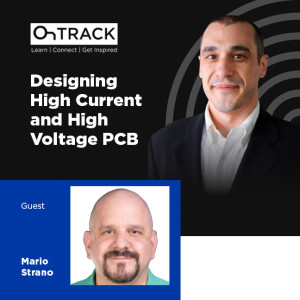
Sunday Jul 17, 2022
10-Ounce Copper PCBs and Design Library Migration
Sunday Jul 17, 2022
Sunday Jul 17, 2022
When you hear about 10-ounce copper PCBs, high current and high voltage come to mind. In this episode, we will have a deep dive discussion on designing heavy power boards with Mario Strano. Mario is the senior PCB designer at Nikola and also president of ECAD Central. He will share with us his 16 years of experience in PCB design and the migration services he provides through ECAD Central.
Watch this episode or listen on the go. We’ve touched on many other interesting topics, such as setting up clearance and creepage rules and a 57-ounce copper board.
Altium 365: Where the World Designs Electronics
Show Highlights:
- Mario’s background and professional path as PCB Designer and Component Engineer
- He is currently the only PCB designer at Nikola
- His expertise includes but is not limited to designing 10-ounce copper boards, real heavy power boards, HMI boards, human-machine interface boards
- Setting up creepage and clearance rules for heavy copper was a challenge to Mario during his transition from SQL Semiconductor to Avnet
- Mario and Zach discuss more 10-ounce copper PCBs
- Zach was amused to hear about Taiyo Kogyo’s 57-ounce copper
- The Japan-based company developed proprietary processes that allow them to do things like Bus Bar Embedded PCB
- Mario briefly shares his experience as a component engineer at Avnet for six years
- The two discuss the tantalum capacitor shortage in 2018 and compare it to the current semiconductors shortage, which started in 2020
- How is the supply chain shortage affecting PCB designers, and how are they working around it?
- ECAD Central, an Altium 365, Concord Pro, and Altium NEXUS Database service provider – setup and configuration, database migration
- Mario compared migrating data to “like moving mountains”
- Is mirroring parts between two systems possible? Mario explains what can be done. Definitely not a simple drag and drop operation, though!
Links and Resources:
Connect with Mario Strano on Linkedin
Visit the ECAD Central website
Learn More about Taiyo Kogyo and their 57-ounce copper boards
Watch related podcasts:
Easily Find Electronic Components for Your Next PCB Design
The Benefits of Diversifying PCB Industry Supply Chain
Connect with Zach on LinkedIn
Full OnTrack Podcast Library
Altium Website
Get Your First Month of Altium Designer® for FREE
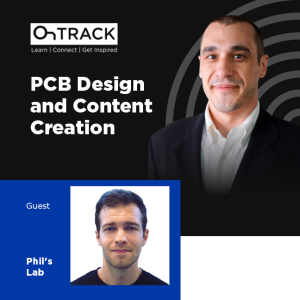
Sunday Jul 10, 2022
PCB Design Education Through Content Creation
Sunday Jul 10, 2022
Sunday Jul 10, 2022
In this OnTrack episode, Zach and Phil of Phil’s Lab Youtube channel exchange ideas on how they can stay on top of their PCB design game or learn new things. Phil Salmony, a successful youtube creator with 64.6K subscribers, shares with us how he was introduced to PCB design, his early career, and what got him to start his own Youtube channel. This is a fun episode. Watch it through the end and check out the additional resources below.
Altium 365: Where the World Designs Electronics
Show Highlights:
- Whiteboard – an essential piece for PCB design-related content
- PCB design education from the university, theories, and ideologies versus PCB design for the real world
- Phil shares that DSPs (Digital signal processors) are the coolest thing, and he has a dedicated section of them on his channel
- Zach and Phil exchange opinions about their consultation and PCB design jobs
- How do you go about learning new things? Zach and Phil have their share of different ways to acquire information to help them better their skills
- Learn through well-documented samples or PCB design projects and reverse engineer
- Seminars with experts and attending conferences
- Taking online courses like the IPC - CID (Certified Interconnect Designers) and PCEA CPCD course
- Youtube videos and keynote presentations, e,g, How to Achieve Proper Grounding By Rick Hartley
- One of the most asked questions in PCB design is about grounding. Phil and Zach suggested a couple of books supplement for PCB design
- Phil talks about how he got started with PCB design
- Designs and chip shortages and supply forecast, what to expect in the next few years?
- The value of connecting with your (youtube channel) audience for content ideas
- Altium Academy and Phil’s Lab history on Youtube and future projects
Links and Resources:
Subscribe to Phil’s Lab YT Channel
Connect with Phil on LinkedIn
Visit Phil’s Lab Website
How to Achieve Proper Grounding By Rick Hartley
Watch Podcast Episodes with Rick Hartley
Electromagnetic Compatibility Engineering by Henry Ott
Grounds for Grounding: A Circuit to System Handbook by Kai-Sang Lock
Get Your First Month of Altium Designer® for FREE
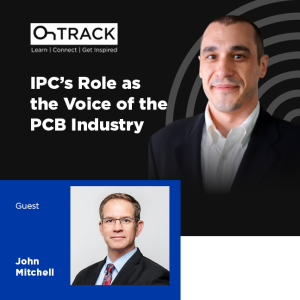
Tuesday Jun 28, 2022
IPC CEO John Mitchell on the Supporting American Printed Circuit Boards Act
Tuesday Jun 28, 2022
Tuesday Jun 28, 2022
Supply chain security and having access to trusted manufacturers in the US would be an ideal outcome of the Printed Circuit Board Act.
IPC President and CEO John Michell talk about how the organization helps shape the current bipartisan proposal to help bring back PCB manufacturing in the US and how this can contribute to a globally resilient supply chain.
Get Your First Month of Altium Designer® for FREE
Show Highlights:
- John Mitchell briefly talks about his background and dives right into the topic, the Supporting American Printed Circuit Boards Act
- John emphasizes the role of the IPC as the voice of the electronics industry
- Supply chain security and having more trusted PCB manufacturers in the US would be a great outcome of the Printed Circuit Board Act
- Adapting the existing legislation on manufacturing defense products to broader use, especially with electronics
- Raise awareness of the different aspects of the electronics supply chain shortages and other issues related to it
- Eradicate the notion that PCBs are just a piece of plastic, but an essential piece in every electronic
- The IPC's influence on shaping laws relating to the electronics
- John explains IPC's role and involvement, which includes solving industry problems related, but not limited to, the workforce, supply chain, and advanced packaging issues
- The IPC SEA Tools: Standards, Education, and Advocacy
- John stresses that having manufacturers in different regions is a key to a resilient supply chain
- Identify what electronic products to manufacture where
- The Printed Circuit Board is a 60 billion industry globally, and only 3-5% of volume comes from the US
- John explains the impact of the changing administrations in the US on the current progression of different bills and legislations relating to the electronic industry
Links and Resources:
Connect with John Mitchell on LinkedIn
Visit the IPC website here
Learn more about the Supporting American Printed Circuit Boards Act of 2022
Watch John Mitchell’s previous episodes:
- IPC CEO John Mitchell on the Impact of COVID-19 on the Electronics Supply Chain
- John Mitchell, CEO of IPC, Visits The White House to Participate in the Pledge to America’s Workers
Watch a recent related episode: The Benefits of Diversifying PCB Industry Supply Chain
Full OnTrack Podcast Library
Altium Website
Get Your First Month of Altium Designer® for FREE
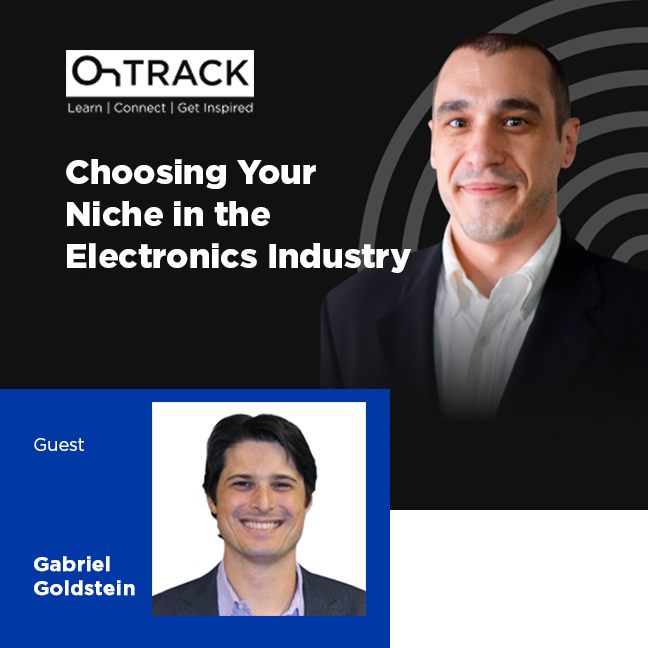
Tuesday Jun 21, 2022
The Electronics Behind a Haunting Attraction
Tuesday Jun 21, 2022
Tuesday Jun 21, 2022
In this episode, a returning guest Gabriel Goldstein shares the electronics behind the thrills in escape rooms. He also generously gives some valuable advice on finding your niche and starting your own electronics business.
Gabriel was the former owner of Anidea Engineering and Escape Room Tech. Listen to this episode and be inspired by how he married two industries together and become the master of this very unique niche.
- Gabriel’s background, he is the former owner of Anidea Engineering and Escape Room Tech
- The business of producing low-volume products - his first big project is an ARM9 with 16 mb of RAM, a PDA style learning device
- The fascinating technology in the escape room includes off-the-shelf surveillance cameras, keyboards, and maglocks. Gabriel describes the technology behind the “magic doors”
- They use RFID and developed their RS45-based networking system
- A successful escape room requires an extreme collaboration of multiple skill sets that include electronics guys, theater guys, and game theory team just to name the least
- The escape room industry is a marriage of electronics and haunt industry
- Creating a small, showpiece project could be a gateway to a PCB design career
- Software engineers have GitHub, while PCB designers have Arduino and Raspberry Pi
- Gabriel wrote blogs to educate his customers about the business of producing products that sell
- He became Mr. Networker hanging out at the Angel Forum groups and the venture capital groups
- For about 6 years he was out there in the community to help out, give back and help build a business
- He recommends a book from Martin Gerber – Awakening the Entrepreneur Within
- “If you're going to take off the engineering hat and try to turn this into a business, please learn how to run a business because it's a completely different skill set”
- Ending the conversation with a little anecdote from Gabriel, an inspiration to be in the business mindset and going for the American Dream
Resources:
Connect with Gabriel Goldstein on LinkedIn
Visit Escape Room Techs website
Read Martin Gerber’s Awakening the Entrepreneur Within
Watch the previous episode with Gabriel Goldstein - How to Build a New Data Management System
Read Gabriel Goldstein’s Blog Articles on LinkedIn
Connect with Zach on LinkedIn
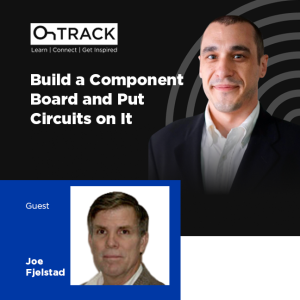
Wednesday Jun 15, 2022
Occam Process: Assembly without Solder
Wednesday Jun 15, 2022
Wednesday Jun 15, 2022
Have you heard of assembly without solder? In this episode, Joseph (Joe) Fjelstad, founder and president of Verdant Electronics, talks about the Occam process.
Let’s hear about Joe’s 50 years of experience in the electronics industry and how he got started with solderless assembly for electronics.
Altium 365: Where the World Designs Electronics
Show Highlights:
- Joe talks about his background and previous roles in the industry, including his position as the educational director in the IPC and Kurchatov Institute of Atomic Research in the Soviet Union
- “Assembly without solder” Joe recollects how he arrived at the idea of a better way to build electronics – build a component board and put circuits on it.
- Joe shares how he came up with the Occam process and its benefits “It absolutely doesn't need to be for everything, but it can be for a lot of things, and it can make products that will be at once cheaper, better performing, lighter, more environmentally friendly.”
- Download Joe’s book for free: Solderless Assembly for Electronics: The SAFE Approach
- More about the Occam Process
- Did Joe coin “Design with Manufacturing”? He shares his efforts in promoting solid work relationships between PCB designers and manufacturer
- Occam Process vs. 3D printing, could 3D printing bypass solderless assembly? Read Joe’s article Putting 3D interconnection technologies into perspective from chip to system
- Joe commended the microvia technology, “they know how to build these things”
Links and Resources:
Connect with Joseph Fjelstad on LinkedIn
Visit Verdant Electronics website
Read Joe Fjelstad Interview: Breaks Down His Occam Process
Download Joe’s book for free: Solderless Assembly for Electronics: The SAFE Approach
Connect with Zach on LinkedIn
Full OnTrack Podcast Library
Altium Website
Download your Altium Designer Free Trial
Learn More about Altium Nexus
Altium 365: Where the World Designs Electronics
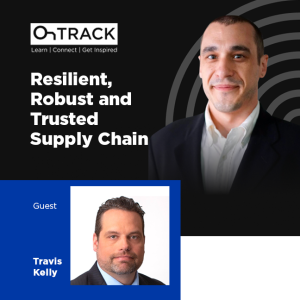
Wednesday Jun 08, 2022
The Benefits of Diversifying PCB Industry Supply Chain
Wednesday Jun 08, 2022
Wednesday Jun 08, 2022
To develop a resilient ecosystem, understanding the root cause of the PCB industry supply chain shortages is a must.
In this episode, Travis Kelly, president and CEO of Isola Group will help us understand what is going on with the current supply chain in the electronics industry. Travis will also give us his insight into the new legislation introduced in the US Congress: Bipartisan Bill to Bring Electronics Manufacturing to America and Strengthen Supply Chains.
Tune in, or listen on the go. Stay up to date with the latest discussion in the PCB Industry.
Altium 365: Where the World Designs Electronics
Watch the video, click here. t
Show Highlights:
- Travis's introduction and a brief overview of PCB manufacturing and fabrication in the United States
- About 20 years ago, the US produced roughly 26% of the world's PCBs; today, that number is down to 4%
- There used to be over 2000 fabricators in the late 1990s and early 2000 to less than 140 today
- What are the main drivers of the PCB industry supply chain shift?
- The industry recognizes the benefits of working in a global economy; Travis explained the need to diversify manufacturing capabilities in certain regions
- Identify what makes sense to have a robust supply chain domestically, e.g., 5G, 6G, medical, aerospace, obviously defense, banking infrastructures
- Travis stresses that there are ways to reduce the overall cost of PCB and electronics production and still manufacture domestically
- Looking at the entire ecosystem and pointing out vulnerabilities outside of just chips and advanced packaging, how to address each one?
- Focus on a balanced approach, not over-indexing; strategically, where does it make sense to build brick and mortar to have a resilient, robust, and trusted supply chain?
- What does it mean to bring manufacturing onshore?
- Building a strategic and competitive PCB industry ecosystem requires more than just automated facilities; it’s also essential to invest on:
- Workforce development – hiring and building up a talented workforce domestically
- Promote STEM in schools
- Create awareness of PCB industry design and manufacturing as part of the sought after career in tech
- Travis gives insight into the new legislation introduced in the US Congress: Bipartisan Bill to Bring Electronics Manufacturing to America and Strengthen Supply Chains
- He emphasizes the importance of understanding the root cost of the imbalanced supply chain vs. addressing just the symptoms
- Continue to educate the Whitehouse on understanding the issue extensively and not just focusing on the semiconductor shortages
- Considering the cost of the end products (for consumers) when navigating and drawing solutions
- The role of the Printed Circuit Board Association of America (PCBAA) in the industry: educate, advocate and legislate
Links and Resources:
Connect with Travis Kelly on LinkedIn
Follow PCBAA on LinkedIn
Visit Isola Group’s website
Eshoo & Moore Introduce Bipartisan Bill to Bring Electronics Manufacturing to America and Strengthen Supply Chains
Connect with Zach on LinkedIn
Full OnTrack Podcast Library
Altium Website
Download your Altium Designer Free Trial
Learn More about Altium Nexus
Altium 365: Where the World Designs Electronics
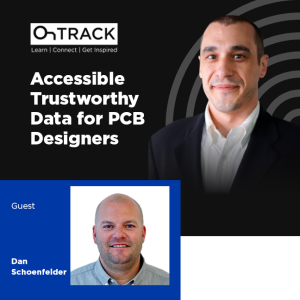
Tuesday May 31, 2022
Easily Find Electronic Components for Your Next PCB Design
Tuesday May 31, 2022
Tuesday May 31, 2022
What is the current state of the electronic industry? Dan Schoenfelder joins us today to discuss the most extreme problems the PCB design industry is currently facing: supply shortages, particularly the semi-conductor products and microcontrollers.
Tune in, or listen on the go. Learn how to keep up with the industry challenges through Nexar and Octopart.
Altium 365: Where the World Designs Electronics
Show Highlights:
- Dan shares his background and role his role at Octopart and now as the Head of Nexar sales
- Problems with the supply chain continue; how are companies coping with the shortages in semi-conductor products and microcontrollers?
- What is lean manufacturing, and what drives an inflexible supply chain?
- The effect of the pandemic on manufacturing facilities is still very apparent and may continue through 2013
- Dan discusses the many benefits of utilizing Octopart to find and access electronic components data easily
- Octopart is the search engine for electronics and makes a great tool to integrate into PCB design workflows
- Dan shares Octopart’s new features, including the ability to filter and search by specs
- How does the Nexar API help with democratizing information in the electronics industry?
- Ability to obtain information through the Nexar API programmatically and incorporate that into native workflows inside the users’ businesses
- Nexar works with the RAI to ensure that all data collected can be trusted
- Dan talks about the Electronic Design to Delivery Index (EDDI), which is meant to provide users with free insight into what's happening in the electronic space in general
- Supply Chain Resilience tools – help designers build thoughtful designs and build BOMs (Bill of Materials) that are resilient to unforeseen challenges
- What’s coming next for Nexar?
Links and Resources:
Connect with Dan Schoenfelder on LinkedIn
Search electronic parts, visit Octopart.com
Design with the PCB Community, learn more about the Nexar ecosystem
Learn more about the Electronic Design to Delivery index (EDDI)
Watch Previous Episode with Dan Schoenfelder: Supply Chain Intelligence from Octopart
Connect with Zach on LinkedIn
Full OnTrack Podcast Library
Altium Website
Download your Altium Designer Free Trial
Learn More about Altium Nexus
Altium 365: Where the World Designs Electronics
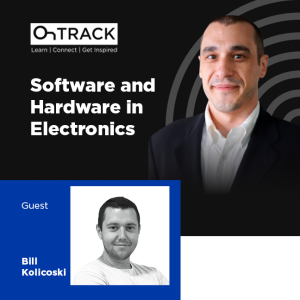
Tuesday May 24, 2022
Making Codes Tangible Through Electronic Projects
Tuesday May 24, 2022
Tuesday May 24, 2022
Learn by doing is what Bill Kolicoski, the creator of Taste the Code Youtube Channel advises everyone who wants to jump into the electronic design. Bill is a software developer passionate about making electronics design and engineering fun.
Altium 365: Where the World Designs Electronics
Show Highlights:
- Bill shares how he got started with his Youtube Channel, Taste the Code
- Bill recognizes that designing and building electronics is a perfect way to understand software or coding – making the code more tangible
- Making electronic design accessible for everyone is one of Bill’s missions in creating his channel
- Jumpstart to electronics design through learning by doing
- Software and hardware coexist–a software engineer should have an understanding of how hardware works
- It’s the eureka moments that help students understand how things work
- Understanding what happens in the code and the chip to make things come to life
- Bill emphasizes improving your design skills by exploring all possibilities how you can improve your finished product
- Reference design for hardware developments and reverse engineering is a great way to make electronics and hardware more understandable
- Bill shares what drove him to pursue software vs. hardware
- Software is a lot easier to outsource
- Location/ country can be a determinant of pursuing a specific career in tech
- Having fun doing electronics
- Getting hands dirty and jumping right into the design process; this and more tips from Bill on how to get into the electronics design and how you can improve your skills
- Search for videos with a specific solution
- Invest time in building projects
- Make your work public and get feedback from the community and professionals
- Rubber Duck Debugging is a software jargon meaning explaining a challenging scenario to yourself to develop a solution
Links and Resources:
Subscribe to Bill’s Channel Taste to Code
Making electronic design easy, visit Upverter website
Register at Altium Education for Free
Altium Designer Free Student License
Connect with Zach on LinkedIn
Full OnTrack Podcast Library
Altium Website
Download your Altium Designer Free Trial
Learn More about Altium Nexus
Altium 365: Where the World Designs Electronics
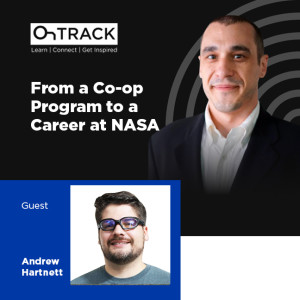
Wednesday May 18, 2022
Landing a Full-Time Engineering Career at NASA
Wednesday May 18, 2022
Wednesday May 18, 2022
This episode will learn how a childhood dream can turn into reality through hard work, determination, and networking. Andrew Hartnett dreamt of working with NASA at a very young age. He will share with us exactly how he landed his Computer Engineer position in this very sought-after agency.
Altium 365: Where the World Designs Electronics
Get Your First Month of Altium Designer® for FREE
Show Highlights:
- Andrew’s background, from his 3rd-grade drawing and high school robotics team to landing a co-op internship program at NASA’s Johnson Space Center (JSC)
- He joined The First Robotics Team in high school
- A lot of networking and determination is what helps him land the co-op internship program
- He started working full-time in January 2010
- Briefly discuss Upverter and the benefits of having high-school level educational programs for aspiring PCB designers
- What is NASA’s co-op internship program? Andrew describes the advantages of the co-op program over a typical internship
- Get exposure to things you don’t get at school
- Experience designing and actual assembly of PCB
- Andrew talks about electronic design standards at NASA and shares details about testing, reliability, and the challenges of sending electronic devices to the space
- Addressing devices’ heat, and vibration in space
- Andrew talks more about First Robotic Competition and stresses the importance of hands-on experience for high school kids or younger
Links and Resources:
Visit NASA’s JSC website
Learn more about JSC’s Internship Program
Making electronic design easy, visit Upverter's website
Register at Altium Education for Free
Altium Designer Free Student License
Connect with Zach on LinkedIn
Full OnTrack Podcast Library
Altium Website
Download your Altium Designer Free Trial
Learn More about Altium Nexus
Get Your First Month of Altium Designer® for FREE
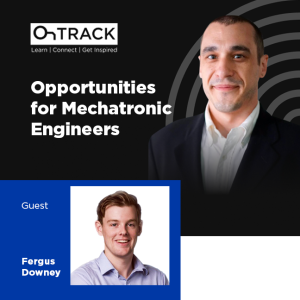
Tuesday May 10, 2022
The Exciting Path to Mechatronics Engineering
Tuesday May 10, 2022
Tuesday May 10, 2022
Continuing our discussion on PCB design education, in this episode, joining us is Fergus Downey. Fergus is a Ph.D. student and research assistant at Curtin University in Western Australia (WA) and is currently involved in the Binar Space Program. Today, we will tackle the education and opportunities related to Mechatronic Engineering and a little overview of CubeSat.
Altium 365: Where the World Designs Electronics
Show Highlights:
- Fergus's background and how he landed on the Mechatronic Engineering path
- How is the space industry in Australia driving the students to pursue an electronics-related career?
- Exposure to CAD tools and manufacturing processes helps students understand circuit design better
- Some projects the students in Western Australia like to work on
- Camera PCBs, radiation center PCB, CanSat PCB design, and more
- What are the main challenges involved in designing CubeSats, and how do Altium Designer® and Altium 365 make a great design tool for these projects?
- Electronic design and redundancy–redundant systems in limited space like in spacecraft
- Fergus talks about his team winning the second place in the #PCBetheChange design competition in 2021 with their entry Swan River Clean Up
- Fergus talks about the Mechatronics Engineering Computer Science degree being offered at Curtin University
- Checkout the Binar Space Program website and connect with Fergus on LinkedIn
Links and Resources:
Connect with Fergus Downey on LinkedIn
Binar Space Program website
Learn more about the Mechatronics Engineering Computer Science at Curtin University
Check out the #PCBeTheChange Student Design Competition Winners
Register at Altium Education for Free
Connect with Zach on LinkedIn
Full OnTrack Podcast Library
Altium Website
Download your Altium Designer Free Trial
Learn More about Altium Nexus
Altium 365: Where the World Designs Electronics
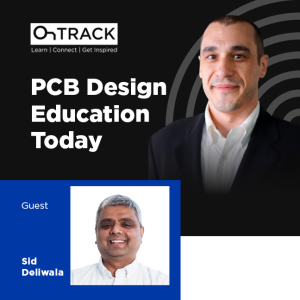
Wednesday May 04, 2022
Hands-on Learning for PCB Design Students
Wednesday May 04, 2022
Wednesday May 04, 2022
In this episode, we will talk about the importance of engaging and exposing the PCB Design students to today’s real-world industry demands. Our guest Sid Deliwala is the Director of Lab Programs in the Electrical and Systems Engineering Department at the University of Pennsylvania. Sid will share with us how he makes Electrical and Computer Engineering (ECE) fun and meaningful for our future innovators.
Altium 365: Where the World Designs Electronics
Download your Altium Designer Free Trial
Show Highlights:
- Sid talks about his background and his advocacy for hands-on training
- Tinker and play – learn the fundamentals, try new things and take risks
- Making the Electrical and Computer Engineering (ECE) major meaningful
- Everything in the circuit world, in the hardware world, is also very data-driven
- End to end experience for students, holistic understanding of Software, hardware, and PCB design
- Preparing students to work in a multidisciplinary engineering environment
- If the cloud, the analog world, and all the digital circuitry that's needed to make things work rolled into one, it'll certainly be a very, very exciting time for all the future innovations
- You don't have to be an expert on everything, but you should at least have been exposed to everything in engineering
- Sid talks about the Penn Electric Racing – every year they participate in FSAE annual competition
- The problem with offshore PCB manufacturing – students have to wait for at least 3-weeks to receive their PCB for their project
- Importance of DFM and the difference it will make for students if they get the chance to visit the manufacturing company
- The supply chain and semiconductors shortage is real, the students experience current industry problems first-hand
- Sid expresses his sentiments toward a completely optimized system, it has some disadvantages
Links and Resources:
Sid Deliwala’s Director Profile, University of Pennsylvania
Podcast with Eric Bogatin: Pathological Design Features
Read Altium’s Newsletter: Staying on Top of the Supply Chain with Altium
Full OnTrack Podcast Library
Altium Website
Download your Altium Designer Free Trial
Learn More about Altium Nexus
Altium 365: Where the World Designs Electronics

Wednesday Apr 27, 2022
Data Security, 5G and Onshore PCB Manufacturing with Dr. Rob Spalding
Wednesday Apr 27, 2022
Wednesday Apr 27, 2022
In this episode, we are very pleased to have Dr. Rob Spalding. He is a retired Brigade General at the US Air Force and now the CEO of SEMPRE (Secure EMP-Resistant Edge), a tech company based in Washinton DC that provides military-grade 5G and high-performance edge computing infrastructure for telecom operators, first responders, government and enterprise customers.
Today, Rob and I will talk about all things security! Rob will tackle the importance of being proactive when it comes to protecting your data, and his advocacy to bring a better understanding of technology and innovation in Washington, DC (White House).
Altium 365: Where the World Designs Electronics
Show Highlights:
- Rob’s background and career before he became the CEO of SEMPRE
- What is SEMPRE? What are the problems it solves and the solutions it offers?
- Rob clarifies what’s written in his 5G report, which was taken out of context in 2018
- He emphasizes building enough spectrum into the network to take full advantage of the 5G technology
- Rob’s take on PCB manufacturing, and semiconductor manufacturing onshore
- Onshore manufacturing has its advantage in controlling and protecting intellectual property
- Most corporations are making decisions on the basis of, what's my margin?
- TSMC has built itself up to be the best chip company in the world because they own the manufacturing line
- Hardware-level security in base stations
- Ability to zerorize crypto–shutting infrastructure down, and shut that thing down physically destroy certain things
- SEMPRE uses FPGAs as a security advantage
- It's data that really drive value in the economy
- If we can’t protect our data, then we can't protect the integrity of who we are as individuals and who we are as a nation
- Rob demonstrates how vulnerable is the public from being spied on
- A recent survey reveals that there will be a talent shortage in the PCB design and manufacturing industry in the next 15 years
- Rob suggests allocation of budget to sponsor American kids through four-year degree programs in STEM
- During the Cold War, the US had initiated education for national security–a lot of scientists and engineers in the space race were educated through this initiative
- The advantages of bringing the manufacturing back to the US
Links and Resources:
Connect with Dr. Rob Spalding on LinkedIn
Visit SEMPRE website
Read about the shortage of talents in the PCB industry in 15 years: In an Unpredictable World, PCB DESIGN ENGINEERING Stays Steady
US Government Calls for Revitalizing American PCB Manufacturing
Connect with Zack on LinkedIn
Full OnTrack Podcast Library
Altium Website
Download your Altium Designer Free Trial
Learn More about Altium Nexus
Altium 365: Where the World Designs Electronics
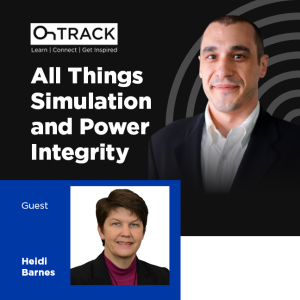
Wednesday Apr 20, 2022
Power Integrity and Simulations with Heidi Barnes
Wednesday Apr 20, 2022
Wednesday Apr 20, 2022
What a very insightful discussion with Heidi Barnes of Keysight. In this episode, we will discuss all things simulations and power integrity in detail. We will dive into EM simulations, capacitor placement, Z, Y, and S parameters correlation measurements, and more! You will learn a lot from this episode!
Altium 365: Where the World Designs Electronics
Show Highlights:
- Heidi’s background and her 30 years of experience in the PCB design Industry
- When she was only 17, she did an internship at Bill and Dave in Santa Rosa, which is now the Hewlett Packard (HP)
- She got into the solar industry and aerospace
- She is currently passionate about signal integrity and power integrity
- Heidi stresses the importance of simulation tools and mentions the need for having reasonable rules of thumb and have an understanding of what to expect before you jump into a simulation tool
- The Keysight’s PathWave ADS ( Advanced Design System) environment, what does it offer?
- Running an EM simulation and getting results through the pro environments– PiPro (power integrity pro), SiPro (signal integrity pro)
- On top of the DC analysis, it features a lot of great asymmetric tolerances analysis, current density, and thermal heat up effects analyses
- Heidi talks about capacitor placement–lowering the path inductance, allowing a higher frequency, and giving a broader power delivery from the printed circuit board.
- Capacitor Placement paper presented at DesignCon
- Addressing specific peaks that are exceeding the target impedance in a problematic PCB
- Heidi’s take on using ferrites
- Steve Sandler has a great video about How to Design for Power Integrity–how to select a regulator
- Z, Y, and S parameters–understanding simulation to measurement correlation
- Heidi wrote a paper on SI Journal website: Power Integrity Fundamentals: Impedance vs. Frequency
- She also tackles the “two-port shunt impedance measurement”
- Watch for another episode with Heidi Barnes, tackling subjects related to all things SI and especially getting into measurement issues, coming soon!
Links and Resources:
Check out Heidi Barne’s articles on SI Journal website
Visit Keysight website
Read a previous interview with Heidi Barnes: Heidi Barnes, Senior Application Engineer and Power Integrity Product Owner
Watch Heidi Barnes Altium 2022 Presentation: What is Target Z and Why is Power Delivery AC Not DC? - AltiumLive 2022
Connect with Zack on LinkedIn
Full OnTrack Podcast Library
Altium Website
Download your Altium Designer Free Trial
Learn More about Altium Nexus
Altium 365: Where the World Designs Electronics
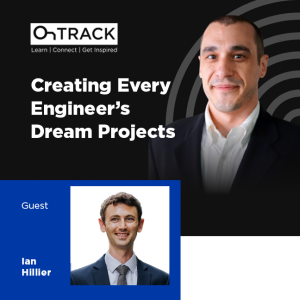
Tuesday Apr 12, 2022
Prototyping Iconic Fictional Objects
Tuesday Apr 12, 2022
Tuesday Apr 12, 2022
The Hacksmith proves that everything is possible through science, one project at a time.
In this episode, Ian Hillier, the COO, and Co-founder of Hacksmith Industry, will share with us what it is like to create a fully working prototype of the coolest and most fascinating objects we see in the movies, comics, video games. He will also talk about how he transitioned from a full-time mechanical engineer to a full-time youtube content creator. Watch or listen through the end! You will hear everything, from the fun, failures, and the success of recreating futuristic, fictional objects.
Altium 365: Where the World Designs Electronics
Show Highlights:
- Ian talks about his mechanical engineering background and how he and his friend James Hobson founded Hacksmith Entertainment Ltd
- James has been publishing his engineering projects on his blog and videos on Youtube for 16 years and decided to do it full-time in 2015 when he reached about 70k subscribers
- Ian quit his job and joined James just six months before getting married
- The duo focused on getting more views by posting viral videos, one of which was the Captain America Shield project
- Hacksmith’s growing team
- From 70k subscribers, they immediately grew to 100k in 2016 and now 12.4 million and still growing
- Their team now consists of 24 full-time members, which includes mechatronics and electrical engineers, videographers, and the merchandise team
- From creating simple, fun projects to upscale mind-blowing lasers, Hacksmith’s bread and butter are turning fictional objects in movies and games, portrayed through special effects, into a working prototype. Some of their coolest projects are:
- Hacksmith's goal as an organization is to encourage future generations of engineers.
- How does Hacksmith operate as a team?
- Each project is assigned to a team, and they can bring additional resources as needed.
- They create and customize everything in-house; their shop is equipped with all the machines and toys they need
- Ian talks about their most extreme and powerful project, the Hoverboard
- Ian’s favorite projects include high current electronics. His personal favorite is the Rebar Crossbow–it pumps 2000 amps through the rebar until it glows red hot, and then you shoot it
- A retractable Lightsaber created with a modified oxy-propane torch
- Ian explains how designing their PCBs contributes to the success of their projects
Links and Resources:
Visit Hacksmith Youtube Channel to watch more of their mind-blowing engineering projects.
Connect with Ian Hillier on LinkedIn
Connect with Zack on LinkedIn
Full OnTrack Podcast Library
Altium Website
Download your Altium Designer Free Trial
Learn More about Altium Nexus
Altium 365: Where the World Designs Electronics
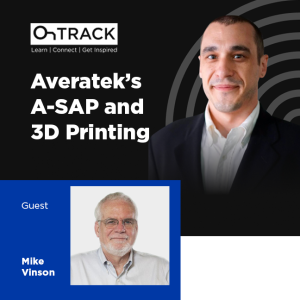
Tuesday Apr 05, 2022
The Many Benefits of Additive Process in PCB Manufacturing
Tuesday Apr 05, 2022
Tuesday Apr 05, 2022
In this episode, we will continue with the topic of Design WITH Manufacturing, and joining us is Mike Vinson, the Chief Operating Officer at Averatek. Mike will help us understand Averatek’s advanced PCB manufacturing processes, including the technology and chemistry behind A-SAP and 3D printing.
Altium 365: Where the World Designs Electronics
Show Highlights:
- Mike Vinson's background
- Mike explains what is an Additive Process
- A-SAP–a semi-additive process used to make very fine features for high definition, and high density interconnects on print circuit boards.
- The ability to add metalization other than copper, such as platinum, gold, palladium
- 3D printing–a fully-additive process where all of the material is just added on, and nothing is subtracted away
- Averatek’s business’s scope
- Licensing the technology and selling the chemistry
- The current clientele is North America
- Efficient and secure prototyping
- Is the 3D surface solderable?
- MIDs or molded interconnect devices, are cool, but are they affordable?
- Tara Dunn, Averatek’s VP in Marketing, is the primary point of contact for licensing
- Tara is also one of Altium’s Industry Expert contributor
- What’s in the Averatek’s IPC Paper
- What does the economy look like for A-SAP technology? Will it be accessible, and cost-effective?
- Mikes talks about the scalability of materials set in A-SAP technology
- How can PCB designers take advantage of the A-SAP capabilities so that they can create more compact, smaller features, more advanced products?
- How about a transparent substrate? Averatek has worked with transparent polyimides and has done some other transparent substrates
- What are the things to look forward to in additive processes and the additive manufacturing realm in general?
Links and Resources:
Connect with Mike Vinson on LinkedIn
Visit Averatek's website
Check out Tara Dunn’s Articles on Altium Resource Hub
Watch Previous Episode Mike Vinson:
Sub-25 Micron Traces with Averatek ASAP Technology
Semi-Additive Process Technology at Averatek
Connect with Zack on LinkedIn
Full OnTrack Podcast Library
Altium Website
Download your Altium Designer Free Trial
Learn More about Altium Nexus
Altium 365: Where the World Designs Electronics
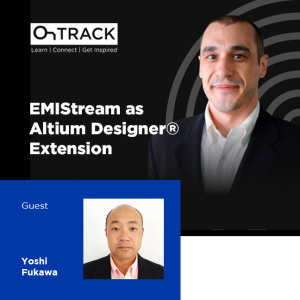
Tuesday Mar 29, 2022
Addressing EMI Issues Early in the PCB Design Stage
Tuesday Mar 29, 2022
Tuesday Mar 29, 2022
EMIStream is now available as an Altium Designer® extension. TechDream CEO Yoshi Fukuwa will tell us how EMIStream can be a lifesaver when addressing EMI issues in your PCB design. Watch through the end, and check out Yoshi’s recent presentation at AltiumLive Connect.
Altium 365: Where the World Designs Electronics
Show Highlights:
- Yoshi founded his company TechDream in Silicon Valley in 2002. Techdream offers EMC, EDA, and PCB solutions. They also carry EDS simulation tools and PCB materials from Oak-Mitsui technologies
- EMIStream was developed by NEC Solution Innovators in Japan about 25 years ago; they tapped TechDream to sell the technology in the United States to help engineers with their EMI problems
- 150 design rules to solve EMI problems narrowed into 15 most important EMI data and rules implemented in EMIStream
- Yoshi Maruyama from NEC Solution Innnovtor is the main guy developing EMIStream in Japan
- EMIStream’s EMI design rule check and plane resonance analysis are available in the Altium Designer environment
- Yoshi explains the two features in EMIStream
- EMI Design Rule Checker
- Plane Resonance Analyzer
- Field Solver approach vs. SPICE approach
- 3D field solver is very good and accurate, but it takes longer to analyze
- EMIStream’s SPICE approach is 20 times faster than a standard SPICE engine
- What do you need to know about embedded capacitance materials?
- Yoshi reveals the number one problem in PCB design during a survey at AltiumLive
- The benefits of SPICE net format in EMIStream
- Catch Yoshi at DesignCon 2022. He will be joining the FaradFlex booth
Links and Resources:
Connect with Yoshi Fukawa on Linkedin
Watch Yoshi’s AltoiumLive 2022 Connect Presentation: Eliminate EMI Problems at Design Stage, Robust EMI Design Rule Check & Plane Resonance Analysis
Visit TechDream Website
Learn More About EMIStream
Full OnTrack Podcast Library
Altium Website
Download your Altium Designer Free Trial
Learn More about Altium Nexus
Altium 365: Where the World Designs Electronics
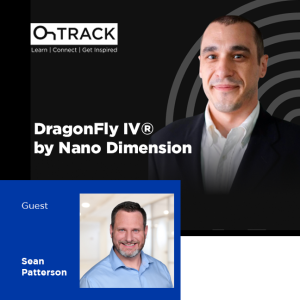
Tuesday Mar 22, 2022
3D Printing Circuit Boards for Fast Prototyping
Tuesday Mar 22, 2022
Tuesday Mar 22, 2022
Let’s talk about the future of printed circuit board prototyping. Sean Patterson, the President of Nano Dimension USA is here to introduce the technology behind DragonFly IV®, the multi-material 3D printer for electronics fabrication. He will walk us through its current capabilities, what it can do and what we may expect from it in the future.
Sit back, relax and enjoy this episode. Make sure to listen through the end and check the show notes with the additional resources below.
Altium 365: Where the World Designs Electronics
Show Highlights:
- Sean talks about the growing company.
- They have 39 members in the US, and 500 globally. There are still plenty of roles available, visit Nano Dimension’s website here
- Started as an additive manufacturing company, specifically for circuit boards to now multi-material, and multi-layer 3D printing option for electronics through
- Sean excitedly shares all the exciting things that the DragonFly IV can do.
- Faster electronic prototyping and proof of concept
- Environmental and sustainability advantages
- A manufacturing plant in the office
- An electromechanical structure that's functionally, mechanically, and electrically, to solve a problem
- The evolution of electronic manufacturing offers a solution that works–there are many better ways, weight reduction, and size reduction
- Nano Dimensions is helping the electronics industry ecosystems systems get prepped now, to support the adoption of this technology
- DragonFly IV uses FR4-like, and the conductive ink is a silver nanoparticle
- What’s the future look like for Nano Dimensions?
- What materials will be available in the future?
- What will be the ultimate capability of the DragonFly?
Links and Resources:
Connect with Sean Patterson on LinkedIn
Visit Nando Dimension’s website here
Full OnTrack Podcast Library
Altium Website
Download your Altium Designer Free Trial
Learn More about Altium Nexus
Altium 365: Where the World Designs Electronics
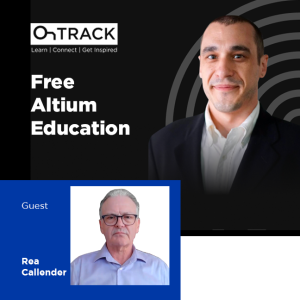
Monday Mar 14, 2022
Master the Basics of PCB Electronics Design and ECAD Software
Monday Mar 14, 2022
Monday Mar 14, 2022
Altium launches a new curriculum into the college in university space called Altium Education. In this episode, Rea Callender, Altium’s Vice President of Education tell us what is in the curriculum, who is it for, and how it will help PCB designers and aspiring designers advance into their career.
Altium 365: Where the World Designs Electronics
Watch the video, click here.
Show Highlights:
- Altium launches Altium Education, which aims to educate anyone who knows nothing about printed circuit board design, to learn the skills to create a printed circuit board, and send it off to manufacturing
- Students can still apply for Free Altium Designer® license
- Altium is taking the lead in PCB Design Education
- Teaching the process of circuit board design
- Modular approach with 16 units that college professors can use to supplement their course
- Student can take the curriculum for free and take it as a self-phase learning tool
- Altium Education have received positive feedback from college professors prior to its launch
College professor - excellent response
- There is currently no curriculum similar to Altium Education, it is a supplemental course, it's not meant to displace anything
- Pcdandf survey reports that in 15 years, approximately 78% of the workforce to retire which may lead to the talent shortage
- Altium Education will help attract talent to the field
- It will equip the students with proper skills in PCB design
- It is designed for High School students, College students, and Professional
Links and Resources:
Register to Altium Education for Free
Connect with Leah Callender on LinkedIn
Yoshi Fukawa Episode - Coming Soon
Connect with Zack on LinkedIn
Download your Altium Designer Free Trial
Learn More about Altium Nexar

